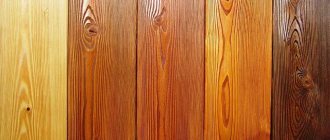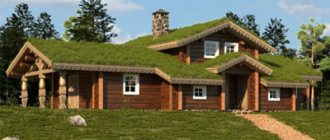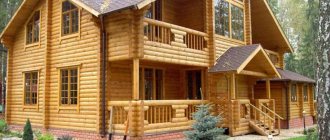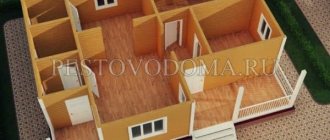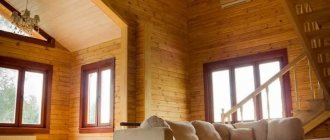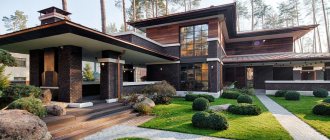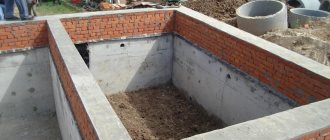Wood is a living material in which biological processes continue long after the tree is cut down. Including rotting during the construction of the house.
Of course, experienced builders know that a log house requires wood dried to a certain moisture content. But the fact is that a house cannot be built in one day. And during storage at the construction site, logs, beams and other lumber are exposed to various natural influences - heavy rains or thaw, hail and simply hot, humid weather.
All this contributes to the fact that the level of humidity in stored materials increases. Because of this, rotting may begin. Therefore, it is urgently necessary to treat the log house with protection against rotting. Because rotting is caused by fungi feeding on substances contained in the tree, which destroys its structural strength.
In principle, all means for protecting a log house from rotting can be divided into three types. These are impregnations containing wood antiseptics and phytoncides, bleaches and preservatives.
How are they different? The way they act.
Impregnations with antiseptics fill the pores of wood materials with chemicals that make it impossible for wood to be consumed as food - not by fungi, not by algae, not by bugs or ants. As if they poison, slowing down and, subsequently, stopping the development of biocontamination. The most effective impregnation is creosote. Railway sleepers and edged lumber impregnated with it last for 70 years. But it is very toxic to people, so it is best to buy modern products.
In our country, you can treat a log house with products produced under the brands “Prosept” and “Neomid”.
Bleach is a remedy for treating already diseased (damaged) wood. The bleaches most often used in Russia are chlorine, oxygen, oxalic acid-based and combined. Their main purpose is to kill an existing infection or rotting that has begun during the construction of a house. Even if you bought high-quality timber, dried and processed at the factory, it still can get spores of wood-decaying fungi during long-term storage. It is almost impossible to detect this visually. And the destruction of strength will continue after construction is completed. Therefore, professionals advise treating all lumber that is subject to temporary storage with bleach for preventive purposes.
And, preservatives. These are certain impregnations that make wood materials resistant to penetration and saturation with moisture. And if there is no moisture, there is no possibility for fungi to live. Usually, preservatives are applied after the above products. In one case, before painting and sometimes used as a primer, in another - after, and in the third - some coating compositions (glazes, glazes, varnishes, paints) contain preservatives.
But in any case, wood that is being processed for the first time must be impregnated with all means in turn separately.
Materials for processing (impregnation and antiseptic) of a log house
Construction of your own country wooden log house involves not only the direct construction of walls, but also the use of various impregnations of antiseptic agents. This is done in order to extend the life of the future home, protecting it from mold, rot and the effects of fungal formations.
Impregnations and antiseptics for wooden houses
Modern impregnations and antiseptics for the home represent a whole range of safety products, the use of which will allow you to better protect the wood from premature destruction. The principle of operation of such protection is based on the fact that the active substance penetrates deeply into the wood structure, interacts with the microstructure and creates a protective shell. In addition to the protective properties, the main thing you should pay attention to is the chemical composition. The latter is explained by the fact that the protective shell created should not interfere with air circulation, disturb the level of humidity inside the room and adversely affect people's health.
Let's give an example of the main areas of work of protective equipment and find out exactly how they protect a tree from the harmful effects of the environment without having a harmful effect on the human body.
- Saline. They are a clear example of comprehensive protection, since with their help you can protect yourself not only from mold, rot, fungus, bacteria, as well as other influences, but also from fire. For use with external cladding only. Please note that such impregnations are strictly prohibited from being used in combination with roofing (for example, metal tiles), since salt will certainly lead to corrosion.
- Water based . The most common and inexpensive. Completely harmless. Their main purpose is to protect against moisture. Therefore, they are often used in combination with salt products to protect the latter from leaching.
- Solvent based . Easily penetrates the wood structure. They are an indispensable tool in the fight against fungus. They protect wood well from moisture absorption and exposure to ultraviolet radiation.
- Based on linseed oil . It is used extremely rarely in the construction of wooden houses due to the fact that it is necessary to regularly update the impregnation structure, and, therefore, entails corresponding financial costs.
Photo: the log house of a wooden house is treated with fire and bio protective materials against fungi that cause rotting of logs and beams. After treatment with antiseptic protective materials Neomid 440 outside and Neomid 400 inside the wooden frame, the logs and beams are impregnated with the decorative composition Neomid Biocolor Ultra on the outside of the frame. The inside of the log house was left without painting. This log processing technology is recommended by experienced construction experts in the field of wooden log housing construction.
Photo: a log house made of rounded logs is treated with protective materials against rot and destruction by fungi that cause rotting of the wooden structures of a log house. Good, effective treatment of a log house with antiseptics will significantly extend the service life of a wooden house made of rounded logs.
Recommendations for selection
The service life of protective equipment is no more than 5 years.
If they write more, we are talking about industrial application. Treatment of logs inside and outside the house is aimed at protecting against many different factors. At the same time, there is not a single protective agent that could simultaneously protect a wooden structure from all negative influences.
There are general rules that allow you to choose a truly effective material that protects a wooden house:
- The service life of any protective coating is from 2 to 5 years. If such a period is indicated on the packaging, the manufacturer is most likely not lying. If a period of 20-40 years is indicated, most likely it is written somewhere in small print that such a period of validity of the product is possible if this product is applied industrially.
- The consumption of the protective agent is important when choosing the brand of material. It often happens that increased material consumption negates the economic effect of low cost. The optimal consumption of any protective agent (except fire retardant) is 200-250 g/m².
- You should not chase universal drugs whose manufacturers promise combined protection against various negative effects. Experts argue that the individual substances included in such products do not enhance each other’s effects, but, on the contrary, worsen them.
- When purchasing a protective product, request a certificate of conformity, which confirms the safety of the material during application and operation.
Protection of a wooden house should be carried out regularly throughout its entire service life.
Advantages of Neomid 400 impregnation
The antiseptic composition Neomid 400 is absolutely safe, because it is made on a water basis. The antiseptic does not contain heavy metal salts. Intended for treating wooden surfaces located indoors only. Both planed and sawn wood can be processed. This impregnation prevents the formation of wood-staining and wood-destroying fungi, mold, and rot. It also prevents the occurrence of wood-boring insects. Neomid 400 provides treated wood with a long period of protection, which is at least 25 years.
The composition of Neomid 400 during processing does not affect the structure of the wooden material, does not change its color and properties. After applying this antiseptic impregnation, the wooden surface can be easily painted or glued. If in the future it is planned to apply glaze decorative impregnation to the wood, then Neomid 400 can serve as a primer.
This antiseptic impregnation is a concentrate. Before using it, dilute the composition with ordinary water, maintaining a ratio of 1 to 5. If the wood will subsequently be located in a damp room, then it is better to dilute it in a ratio of 1 to 3. This concentrated type of impregnation allows you to save money, i.e. when purchasing 1 liter of the composition, the result will be 4 - 6 liters of finished antiseptic.
The problem of excessive timber moisture
Wood is a living material, and even after cutting down the tree itself, biological processes in it do not stop . Unfortunately, one of these processes is rotting.
Professional builders know very well that a log house requires wood that has been dried to the required moisture content. However, the main problem is that the house is not built in one or two days. However, lumber, logs and other lumber are usually stored in an area where they can be exposed to the environment: rain, hail, wind or simply heat and humidity.
All these conditions increase the level of moisture in the wood, and rotting processes begin to develop there. Because of this, it is urgently to treat the materials with anti-rot agents, because the fungi that cause this process feed on substances contained in the wood and gradually destroy its structure.
There are a lot of products that protect wooden materials from rot and mold, all of them can be divided into 3 types :
- impregnations that contain antiseptics;
- bleaches;
- preservatives
What is their difference? In methods of exposure and methods of application.
Advantages of Neomid 440 Eco impregnation
The colorless, safe antiseptic composition Neomid 440 Eco is intended to provide protection to wooden materials from the effects of various types of mold and fungi indoors and outdoors. Also to prevent the formation of moss, lichen, algae and the invasion of various wood-boring insects on wood. Antiseptic impregnation Neomid 440 Eco can eliminate existing contamination of the material. This composition provides the treated surface with a long period of protection, which is about 25 years.
Neomid 440 Eco can be used for application to wood located in a room with high air humidity (basement, bathroom, cellar, etc.). After the treatment, the structure of the wooden material does not change. In the future, it can be easily painted, glued, etc.
Why is it necessary to treat the walls of premises?
Wood materials have the ability to absorb moisture. Any changes in humidity or temperature levels will lead to their destruction. Externally, this will manifest itself in the form of swelling, drying out of the walls, the appearance of cracks on the outside, or the tree may simply begin to rot.
In addition, there are a number of microorganisms that can spoil wood materials. These are fungi, algae and insects that can cause unwanted darkening of walls, as well as stains on the outside of the house and mold indoors.
It is very important to protect your home from a possible fire.
Where can I buy these quality products?
Photo: the most popular antiseptic and decorative impregnations of the Neomid brand.
You can buy high-quality wood preservatives for processing wooden log houses, high-quality sealants for wood, from our company, which is the official dealer of effective impregnations Neomid and Prosept.
Call, check the availability and cost of wood protection products for wooden log and timber frame houses.
Wood bleaches
Bleach is used to treat already infected wood and prevent it from darkening. They come in different types; in Russia they usually use chlorine, oxygen, oxalic acid-based and combined ones. Their task is to neutralize the infection and decay that has begun. It must be remembered that even high-quality wood materials that have been dried and processed in a factory can develop fungi if they are stored outdoors. However, this may not affect the appearance. But the wood will continue to deteriorate after construction. Therefore, experts recommend treating all materials that will be stored for a long time with bleach for prevention.
Procedure for applying protective agents
- The wood needs to be sanded (especially if you are working with an old log house), this will allow you to get rid of cracks and irregularities:
- First, the wooden house is treated with an antiseptic in 2-3 layers.
- Each layer is applied after the previous one has dried. The entire surface of the tree must be covered.
- Products containing preservatives are applied. The ends are covered with 4-5 layers, and the sides with two.
- The primer, which contains bleaches, is applied both inside and outside.
To ensure that your home does not suffer from weather conditions and insects, treat it every 5-7 years.
How to treat logs
The choice of special compounds for treating wooden surfaces is very wide. For the most part, all popular antiseptics provide good protection against moisture and insects, the only thing is that you need to not confuse the means for external treatment and internal treatment. Indoors, compounds are usually used that do not release substances harmful to humans.
Internal processing of log houses
Treatment of logs on the inside is also necessary, although operating conditions will be more gentle than on the outside, but the humidity level can vary over a wide range, and you should not forget about insects.
As for the types of products used, the following types of solutions can be distinguished:
- easily washed out - as an example, saline solution can be used. This is too much of a budget option; it can only be recommended for processing auxiliary buildings and then as a temporary measure;
The saline solution can be used to treat surfaces that will not be exposed to rain.
- penetrating - treating rounded logs with this composition guarantees the penetration of the antiseptic to a decent depth (depending on the type of wood, but in most cases it will reach a depth of 5-7 mm). They do not wash out over time, and also allow the wood to breathe;
- film-forming - used rather to decorate the surface of the wood; the liquid does not penetrate deep into the wood. Such compositions are applied after impregnation with an antiseptic to give the desired shade to the wood.
To treat wooden surfaces inside the house, you can use, for example, SenezhAquadecor. It does not stain the surface of the wood, is absorbed deeply enough and does not create an impenetrable layer on the surface after drying, so the logs are not in danger of rotting from the inside.
One of the good options for interior work
Processing of a log house after installation of logs includes impregnation of rafter frames, as well as elements of wooden floors. Since they will not be visible, it is advisable to use compositions with coloring properties. This is done so that the treated and untreated areas can be clearly distinguished.
Antiseptics can paint wood a green tint, but the tint of the surface treated with a fire retardant is reddish. Of course, such compositions are not suitable for treating floors or ceilings.
The base of the rafter system is treated with an antiseptic with a green tint
External processing
Treating a log house with protective compounds on the outside gives much greater scope for creativity. At the same time, antiseptics can be used both as a prophylactic agent and for the preservation of existing defects.
Note! Treatment with a potent compound will freeze the development of rot in the wood, but there is a limit to everything. If the log is severely damaged, then no amount of impregnation will help.
When processing externally, you will have to solve several problems:
- carefully caulk the cracks and cracks in the logs;
- the ends of the logs are also processed (a separate compound is used);
- Only after this can you proceed to sanding the wall and applying antiseptic.
Wide and deep cracks in logs are far from uncommon; because of them, moisture and insects can easily reach the especially vulnerable central part of the log.
Fortunately, sealing cracks can be done with your own hands; for this you will need:
- clean the crack from dust and dirt;
- push the sealing material inside (there are special cords made of synthetic materials on sale). You can also use ordinary natural fabric;
The correct sequence of actions when filling joints and cracks with sealant
- then fill the rest of the crack with sealant; it is quite elastic, so when the house settles it will still provide a reliable connection between the edges.
Carefully filled joints and cracks look great
The question of how to treat the ends of logs is especially important because it is through the ends that the logs lose moisture at an accelerated rate. This is what causes cracks to occur. In addition, through the ends it is easier for moisture and insects to penetrate inside.
The photo shows an example of a careless attitude towards protecting logs
Note! To treat the end of the log, special compounds are used that slow down the evaporation of moisture.
Usually the problem of how to process log sections is solved at the stage of harvesting round timber, but it is better to play it safe and process them yourself again.
To do this, you can use both folk and purchased remedies:
- The simplest recipe is to apply paraffin; this “chemical dead man” is guaranteed not to let moisture in;
Paraffin will preserve the original appearance of the end of the log
- You can also use purchased compounds, the same “Senezh TOR” does not contain substances harmful to humans, and treating log logs with an antiseptic at the ends normalizes the shrinkage of the log in the transverse and longitudinal direction.
Does chopped sauna require processing?
If there are no particular problems with the question of how to treat the outside of a log house, then in the case of a wooden bathhouse you have to take into account the specifics of its operation. Experts are still inclined to believe that impregnation with an antiseptic from the inside is not necessary.
In this case, it is advisable to use debarked or planed logs with sufficiently high natural protection (meaning the content of resinous substances) as a building material. You just need to take into account that the use of tree species with a high resin content is unacceptable; due to the high temperature, the walls will be constantly sticky.
Recommendations for the use of different tree species
In principle, the instructions allow the processing of a chopped bath from the inside, but with a number of reservations:
- it is forbidden to use compounds that, when exposed to high temperatures, release harmful substances (that is, the lion's share of antiseptics is immediately eliminated);
- The wood must remain breathable.
If the problem of how to process the logs inside the bathhouse is perplexing, then you can try to limit yourself to external processing only. If the inside of the wood darkens a little after some time, you can simply sand the logs with a flap wheel; a pleasant shade of natural wood is guaranteed for several years.
Main grinding tool
Note! Various folk remedies, for example, based on beeswax, oil, resin, etc., are not suitable for internal bath treatment precisely because of their low resistance to high temperatures.
If the bathhouse is built from inexpensive calibrated round timber, then external treatment is required. Considering that harmful substances have an unpleasant tendency to seep through wood and enter the air (especially at high temperatures), the product must be 100% harmless.
In principle, you can purchase logs already impregnated with a protective composition, but the question of how best to treat a rounded log in a bathhouse is still better to decide for yourself. The fact is that during factory impregnation, they don’t really think about the environmental friendliness of the antiseptic.
What happens if you don’t process rounded logs?
Rounded logs are a very capricious material. If you don't process it, it will collapse. The main source of destruction will be microorganisms. Mold, mildew and bugs will settle in large groups inside the tree and begin to eat it from the inside. As a result, the logs will lose their aesthetic appeal and structure. Blue and black spots will appear. The house will gradually begin to collapse.
Another negative factor for rounded logs is sunlight. They heat the material very much. Rotting of weak zones and subsequent destruction occurs.
1.1 Factors of destruction and aging of logs:
- ultraviolet radiation;
- strong temperature fluctuations;
- constant gusts of wind (sudden changes in direction);
- air oxygen;
- seaweed;
- bacteria;
- flowering plants;
- large insects.
1.2 Consequences from exposure to destructive factors:
- a rounded log will lose strength;
- its mechanical and physical properties will deteriorate;
- color changes;
- rotten places appear.
Wood for building a bathhouse, secrets of its protection and processing
The stages of processing a log house for a bathhouse have their own characteristics. For a bathhouse, it is recommended to use a frame made of coniferous or deciduous wood.
Today, pine is especially popular among customers. Its cost is low, while it deforms little and practically no cracks form on it. The natural release of resin allows you to protect the structure from heat and temperature changes. But due to the resin, internal treatment and additional lining of the premises will be necessary. Experts have compiled several requirements for a log house for a bathhouse, which will help you choose the best option:
- the wood should not emit a lot of resin;
- minimal chance of spontaneous combustion;
- pleasant aroma after heating;
- ability to withstand temperature changes.
Wood preservatives
These substances cover the wood with a thin film and protect it from moisture penetration, because a humid environment is ideal for the occurrence and proliferation of fungi and mold. In most cases, wood is treated with preservatives after the above remedies. But, depending on the type of preservative, they are used before painting, sometimes as a primer. And also many azures, paints and varnishes already contain preservatives.
When and how should compounds be applied to a log?
Before applying any composition, you need to dry the log. Wet wood will create a strong obstruction. It will not allow the antiseptic to penetrate deeply into its structure.
First, you should protect the ends of the log. For this purpose, antiseptics that allow steam to pass through are used. This will solve the problem with possible cracking. The main processing is done after the material shrinks. This takes approximately 6-12 months. Manufacturers of rounded logs can apply a transport antiseptic to the product. This is done at the request of the customer, since the procedure is advisory in nature. It is especially popular in the summer months, when the air temperature is very high. Because the logs heat up and become vulnerable. Insects quickly colonize them.
The shrinkage of the material has ended. It's time to apply the main protective layers. Builders use decorative antiseptics. This allows you to preserve the aesthetic beauty of the house.


